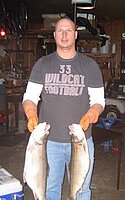Stoichiometry and the transfer of mercury from benthic macroinvertebrates into game fish

Dan McEwen is a PhD Student
Department of Biological Sciences
BA, Biology (2003) Minnesota State University - Moorhead
Email: daniel.mcewen@ndsu.edu
Fellow: Daniel C. McEwen, Department of Biological Sciences, NDSU
Advisor: Malcolm G. Butler, Professor of Zoology, NDSU
Matching Support: NDSU
Degree Progress: Ph.D. expected in December 2008
Stoichiometry and the transfer of mercury from benthic macroinvertebrates into game fish
Mercury (Hg) damages the central nervous system, altering the way that nerves conduct electrical impulses and divide, leading to lowered cognitive and metal functioning or in especially acute circumstances cerebral palsy, mental retardation or death. Its effects are especially harmful to fetuses or infants during development of the nervous system. Hg emissions have continued to increase since the industrial revolution, entering aquatic food chains via atmospheric precipitation where they suspend in the water column and are up taken by phytoplankton or settle to the bottom where they become available to bacteria. Phytoplankton, with acquired Hg, is either ingested by zooplankton or sinks to the substrate as detritus. In turn, detritus and bacteria provide a food source to macroinvertebrate benthic organisms (i.e., benthos) and bioaccumulation occurs up through trophic levels eventually to game fish that are consumed by humans. As a result, the EPA and various state agencies issue advisories for fish consumption where impairment occurs. The North Dakota Department of Health currently has consumption advisories listed for Devils Lake, Red River, Lake Oahe/Missouri River, Lake Sakakawea, and other waterbodies. I proposed a research program addressing taxonomy, stoichiometry, and benthic-pelagic coupling in the context of benthic contribution to Hg accumulation to fisheries in Minnesota and North Dakota lakes along a trophic gradient from oligotrophic to eutrophic.
Objectives and Methods:
The objectives of this study are as follows:
- Characterize the benthic community of lakes under a variety of nutrient regimes
- Quantify the biomass of the constituent members of the benthic communities in those lakes
- Quantify carbon, nitrogen, phosphorus, and mercury ratios for those communities as a whole
- Model how those ratios impact rates of mercury accumulation and concentrations in piscivorous game fish likely to inhabit those lakes (e.g., lake trout, walleye, smallmouth bass, northern pike, etc.)
- Use appropriate regression models to test whether there is a relationship between Hg and P (as a limiting nutrient) in the benthos
- Provide applicable information for managers of mercury-susceptible systems
Twelve lakes will be sampled during the summer of 2006 for benthic invertebrates including 3 deep, oligotrophic trout-lakes in the northeast Minnesota, 3 shallow-eutrophic lakes from North Dakota and 6 mesotrophic lakes in Minnesota and North Dakota. Each lake will be sampled using a stratified sampling method, with 20 grabs per lake comprised of 60% of sampling effort at <1 m and the remaining effort split between two strata based on depth. Sampling sites will be randomly chosen using a grid on bathymetric maps, and sites will be located in the field with a GPS and depth finder. All grabs from a lake will be pooled and organisms will be separated to order or family. Samples will be dried for 24 h and dry mass will be recorded for each taxonomic group. All organisms will be homogenized and ground and subsamples will be analyzed for carbon, nitrogen, phosphorus, and mercury. These data will be used in a bioenergetics model to predict game fish species mercury concentration levels using literature-derived values for parameters not measured in the field.
Project Progress:
I have developed our benthic sampling and fauna sorting technique over the summers of 2004-05 in a related project. Computer software has been obtained for bioenergetics modeling, and I have been successful in developing mock models with fictitious data that represent those that will be empirically derived. I am in the process of determining phosphorus concentrations of invertebrates and have contacted laboratories that provide carbon, nitrogen, and mercury analysis services. Presently, I am conducting an in-depth literature review on stoichiometric theory as well as the environmental toxicology of mercury accumulation in aquatic systems.
Significance of Research:
I will provide a framework by which lakes can be assessed for susceptibility of Hg concentrations. A stoichiometric underpinning can provide managers with a relatively easy method of assessing fish susceptibility to Hg by measuring a subsample of benthos for C:N:P. Manuscripts will be prepared for the bioenergetics models produced in terms of the relationship between nutrient limitation and Hg accumulation.

Melcolm Butler
Biological Sciences
Office: Research 2, Room 214B
Phone: 701-231-7398
Email: malcolm.butler@ndsu.edu


